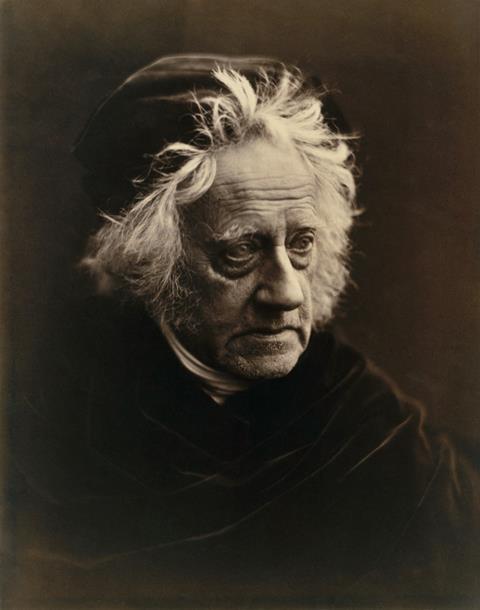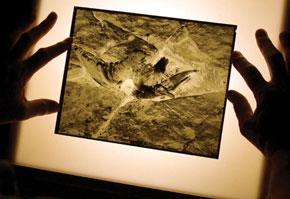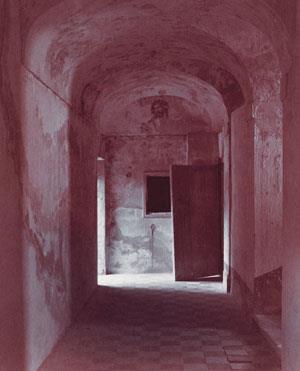In the commercial battle between digital and analogue photography, physics eventually prevailed. Here, Mike Ware reveals how chemistry shaped the history of photographic images
For 150 years, the science of chemistry and the art of photography have been entangled in a close relationship. A partnership that, according to a 1858 edition of the literary magazine Athenaeum, was not entirely equal: ’The artists go on boldly and are not afraid to be chemists; the chemists gain courage and long to be artists.’

However bold the artists, without a theoretical guide it was experimental chemistry – trial and error – that led the way. In 1840, the polymath Henry Talbot happened upon the discovery that gallic acid (3,4,5-trihydroxybenzoic acid) could ’bring out an invisible dormant picture’ which had been briefly projected upon a layer of silver iodide in a camera obscura. This phenomenon – now called the development of a latent silver image – was, at the time, utterly inexplicable. Photography was a ’black art’. Talbot’s friend and eminent colleague in the Royal Society, Sir John Herschel, jestingly called the effect ’really magical’, and asked, ’surely you deal with the naughty one?’ Devilry aside, the true explanation of the latent image in silver halides would have to wait a century, until the quantum theory of solid state chemistry was established.
But the successful partnership of chemistry and photography was finally disrupted late in the 20th century by the rise of digital technology. The convenience of electronic image manipulation using personal computers moved the entire scientific basis for the practice of photography from chemistry to physics. Today, images are recorded on charge-coupled devices and printed piezoelectrically by ink-jet printers. Multitudes of photographers have now deserted their wet (and sometimes smelly) darkrooms, in favour of the dry comforts of their desktops. Moreover, many who were unable to print their own photographs in the traditional way can now do so with ease. For most purposes, the analogue silver image on cellulose paper or polymer film has been replaced by a computational abstraction – the string of binary digital code. Pixels substitute for silver grains, and the photo CD serves instead of the roll of negative film. Photography has also fallen in with a new partner – the internet. The processing and electronic transmission of pictorial information within our culture has now reached unparalleled speed and ease. Which raises the question: is there any place left in today’s photographic technology for new chemical science?
Seeing the light
Talbot made his first camera negatives in 1835 on his ’photogenic drawing paper’ using silver chloride. Rather than ’develop’ these, he ’printed them out’ entirely by the action of light alone. This was not an efficient process – it took him about an hour’s exposure with the lens open (at a wide aperture of f/4) to record those first weak images with his tiny cameras that his wife Constance referred to as ’mousetraps’.
But the chemistry improved and the cameras grew larger. Talbot’s subsequent discovery of the latent image improved the sensitivity [to light] by a factor of about a hundred, so his ’calotype’ process of 1840 required camera exposures of a minute or less. This made photographic portraiture possible for the first time. His negative-positive process on paper set photographic science on the road to success. By the middle of the 20th century, the effective quantum yield (the reaction produced by one photon of light) from gelatine-silver halide camera emulsions had improved dramatically. A typical camera exposure to an average subject was just 1/100 of a second at a much smaller aperture (f/8).

This marriage of science and art was founded on the unique photochemical properties of silver halide crystals suspended in a gelatin film, the misnamed ’emulsion’ of photography. Taken up by George Eastman’s Kodak Company in the US, the technology became embodied in a large and profitable industry, serving a huge constituency of users, both amateur and professional. This commercialisation gave analogue photography the benefit of rapid technical development towards the pinnacle of optical recording.
The history of photographic science is studded with chemical triumphs. An early example is Herschel’s use in 1839 of sodium thiosulphate to ’fix’ the silver image by complexing and dissolving out the excess insoluble halide. In the 1920s, Samuel Sheppard at Kodak discovered that traces of thio-organics, such as allyl isothiocyanate, were responsible for the enormous increase in the photosensitivity of the emulsions made with bovine gelatine. As he put it, 'If cows didn’t like mustard [plants], there wouldn’t be any movies at all.’
In the 1980s, the technology of ’tabular grain’ crystal growth brought the quantum efficiency of developed silver halides even closer to the theoretical limit. The latent image in a single silver halide crystal, which renders it entirely reducible to silver by ’developing’ agents such as aromatic amines and phenols, consists of a ’sensitivity speck’: a tiny cluster of about four silver atoms.
Printing in metal
Most photographic practice entails two separable stages. First, acquire the image information, and then – at some later stage – print it in a visually acceptable form. For the near-instantaneous capture of analogue negative images in the camera, there has never been any viable chemical alternative to the uniquely fast ’emulsion’ of gelatin-silver halide. But making a positive print from a camera negative is much less exacting: it is no great disadvantage to use lengthy exposures and intense ultraviolet printing lights, which open the door to a whole range of photochemical systems, less sensitive than silver halides.
For print-making there are many alternatives to the ubiquitous silver technology, most of which were discovered in the dawn of photography. In 1839, the Scot Mungo Ponton noted a light-induced colour change in dichromates coated on paper, corresponding to the photoreduction of chromium(VI). Ultimately, chromium(III) results, which can insolubilise a colloidal layer binding a stable pigment. This technique was used to bind pigments in the ’carbon process’, commercialised by the London-based Autotype Company in 1866, and in the painterly ’gum-bichromate’ printing process. Both processes provide images as permanent as the artists’ pigments they employ.
The seminal discovery of ’siderotype’, or iron-based photographic printing, was made by Sir John Herschel in 1842: iron(III) in certain carboxylate salts can be photoreduced to iron(II), which is then reacted to make permanent images: either by the reduction of noble metal salts such as silver (argentotype), gold (chrysotype), or mercury (celaenotype).

The iron(II) can also be coupled with hexacyanoferrate(III) to make the pigment Prussian blue (iron(III) hexacyanoferrate(II)). This was Herschel’s cyanotype process, which became the first commercially important method of reprography – the blueprint. Entirely organic photosensitive substances were also pressed into service, some literally: Herschel extracted coloured anthocyanins from the flowers of his Kentish garden to serve in his ’anthotype’ dye-bleaching process.
He also attempted to make prints in platinum by his iron-based route, but was unsuccessful. A working platinotype process had to await the research and enterprise of William Willis, who made the key discovery in 1873 that it was necessary to use the (then uncommon) platinum(II) salts, rather than platinum(IV) salts, for a successful reduction. Willis marketed his platinotype paper in 1879, although it took him twenty years to perfect the process. The platinum print became widely acclaimed for its permanence and artistic effect. By 1900 the salons of photography were exhibiting more platinotypes on their walls than any other process. The medium displays pleasing characteristics: a totally matte paper surface and subtle grey tonal scale, with an aesthetic appeal similar to those highly-esteemed media for other works of art on paper – etching, engraving, and mezzotint – the first printing method to give tonal qualities. Art connoisseurs appreciated the ’platinum look’ and its permanence, contrasting it with the glossy, brown silver-albumen prints of the day, which also suffered from the vulnerability of silver to sulfiding, and consequent fading – a common fate of photographs exposed to the polluted atmospheres of Victorian England.
Siderotype chemistry
Siderotype printing relies on the photochemistry of iron(III) carboxylate, and its subsequent reactions with gold. First, trisoxalatoferrate(III) anion undergoes an internal redox reaction induced by light with a wavelength of about 365 nm:
hn + 2[FeIII(C2O4)3]3– → 2[FeII(C2O4)2]2– + 2CO2 + C2O42–
The resulting iron(II) oxalato complex can reduce noble metals from their salts:
[AuCl4]- + 3[FeII(C2O4)2]2– → Au + 3[FeIII(C2O4)2]– + 4Cl–
But gold(III) is sufficiently oxidising to react with oxalate anion:
2[AuCl4]– + 3C2O42– → 2Au + 6CO2 + 8Cl–
so the constituents of the sensitiser cannot be pre-mixed.
A night at the palladium
But the triumph of platinotype was short-lived, thanks to the discovery by Friedrich Wilhelm Ostwald in 1902 of the catalytic power of platinum in the oxidation of ammonia to nitric acid. In 1916, at the height of the Great War, the combatant governments banned the use of platinum for frivolous purposes such as photography and jewellery, and elevated the metal to the status of a strategic material, reserved for making nitrate explosives. Willis immediately devised a palladium printing paper as a substitute.
His Platinotype Company survived until 1937. Its ultimate demise was due to the limitation suffered by all the iron-based processes: the necessity for printing by contact, using a same-sized negative, to allow a sufficient throughput of light. The growing use of miniature cameras that recorded negatives onto rollfilm meant that enlargement by projection became the norm, requiring a sensitivity which only silver photography can offer.
But during the late 1970s, a rebellion began against the uniformity of the commercial silver-gelatin enlarging papers provided by the market-driven industry. A few photographic artists started hand-sensitising their own papers, leading a contemporary renaissance in alternative photographic printing, using long-forgotten 19th century processes. So platinum-palladium printing has regained its place as a minority practice for an elite band of photographers. In this era of mass production, handmade photos in platinum metals carry a certain cachet, and can claim greater permanence, than the silver or ink-jet prints on commercial materials.
The new chrysotype process
This process relies on the ligand 3,3’-thiodipropanoic acid, S(CH2CH2COOH)2, used in the neutralised form of its disodium or diammonium salts, which are highly soluble in water. The reaction of this thio-ether (written below as SR2) with tetrachloroaurate(III) takes place in three steps:
i) Coordination to gold(III): [AuCl4]– + SR2 → [AuCl3SR2] + Cl–
ii) Reduction to a two-coordinate gold(I) complex by a second molecule of ligand: [AuCl3SR2] + SR2 + H2O → [AuClSR2] + OSR2 + 2H+ + 2Cl–
iii) Excess ligand may displace the chloride ion from the gold(I) complex: [AuClSR2] + SR2 → [Au(SR2)2]+ + Cl–
Forgotten colour
Throughout this history, platinum’s neighbour gold was ignored as a potential image substance in its own right, although the metal had been used extensively from the earliest days of photography to tone and stabilise silver images by partial electrochemical displacement.
Herschel’s pure gold printing process – his chrysotype of 1842 – never gained admission to the photographic repertoire, and by 1900 it had been entirely discounted as ’dead and buried’. The problem lay with the chemistry: the simplistic 19th century method used the easily-available salts of tetrachloroaurate(III). This could not be mixed with the iron(III) carboxylate sensitiser, owing to redox instability which causes the premature precipitation of gold metal. Instead, the gold salt had to be employed in a developer bath, which was uneconomic. The answer, which I discovered in 1986, was complexation and reduction to gold(I), to provide an efficient and economic mixed sensitiser. The new chrysotype process is a close analogue of the celebrated platinotype, but brings one exciting extra benefit: colour.
Since the Middle Ages, it has been known that gold salts can impart rich ruby reds and purples to ceramic glazes and glasses. Purple of Cassius, discovered by the proto-chemist Johann Rudolf Glauber in 1656, is now known to be nanoparticle gold in a matrix of tin(IV) hydroxide. The origin of this colour was first established by Michael Faraday in 1856 as due to the formation of highly dispersed gold, but it was not until 1904 that Gustav Mie explained its visible absorption spectrum with a classical scattering theory based on the application of Maxwell’s equations to spherical metallic particles. The strong absorption band of nanoparticle gold in the visible region around a wavelength of 520nm is due to a surface plasmon resonance – a collective oscillation of the delocalised conduction electrons – and its wavelength is dependent, among other things, on the radius of the metal nanosphere. Thus the colour of gold images may be tuned by reactions yielding nanospheres of differing sizes. If the particles are ellipsoidal, rather than spherical, two absorption bands are generated and green gold can result. These developments have provided creative photographers with a new palette of non-literal or ’surreal’ colour to enhance the expressiveness of their imagery, while also forging an invigorating new link between the graphic arts and the burgeoning science of nanotechnology.
Enduring images

Analogue photographs – negative or positive – are repositories of pictorial information in a form easily handled and stored as permanent, flat objects. Their complete independence of any prevailing computer technology ensures that, providing they are well prepared, they will remain humanly readable forever. It is hard to see how machine-dependent, digitally-encoded images can ever lay claim to such robustness and accessibility. The end of the traditional photographic negative and printed record would prove a great loss to many historical photographic archives.
Although ink-jet printer pigments are improving in their endurance, some photographers prefer a hybrid practice. They employ digital techniques to ink-jet print large negatives onto transparent film (which may well prove ephemeral) but then use them to print positives in gold or platinum upon a substrate of the finest cellulose paper. Such a print can endure for a millennium. This union of the noblest metals with the commonest organic substance on earth also provides the artists with a satisfying embodiment of being true to their materials.
Mike Ware is honorary fellow in chemistry, University of Manchester
Further reading
M Ware, Gold in photography, Brighton: Ffotoffilm, 2006
M Ware, The chrysotype manual, Brighton: Ffotoffilm, 2006












No comments yet